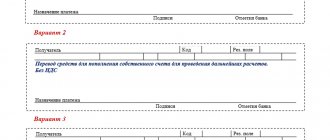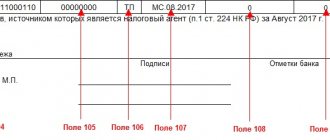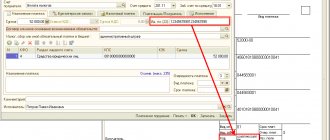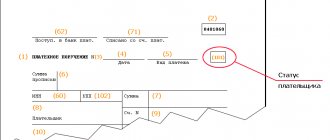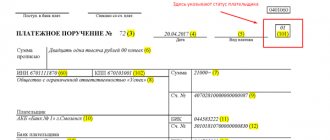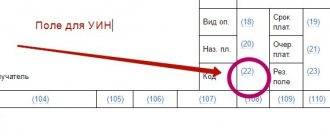The transfer of administration of insurance premiums to the Federal Tax Service has raised many questions. One of the most relevant: what payer status for payment of insurance premiums from 2021 should be indicated in field 101 of the payment order? Previously, we published material on the issues of filling out payment orders for insurance premiums in 2017. And here we will only touch on changes in filling out field 101.
It is known that the rules for filling out field 101 in a payment order are regulated by Appendix No. 5 to Order No. 107n of the Ministry of Finance of the Russian Federation. But the currently valid version of this application does not contain a status that could undoubtedly be applied to the policyholder transferring contributions to the Federal Tax Service. Let us remind you that before the transfer of administration of insurance premiums to the Federal Tax Service, it was necessary to indicate code “08” in all cases in the payment order for payment of insurance premiums.
In turn, in 2021, the Ministry of Finance of the Russian Federation published a draft order “On amendments to the order of the Ministry of Finance of the Russian Federation No. 107n.” This document states that when transferring insurance premiums by legal entities, code “01” must be indicated in field 101. Individual entrepreneurs paying insurance premiums “for themselves” must indicate payer code “09”, individual entrepreneurs paying insurance premiums for employees must indicate payer status “14”.
But this draft Order has not yet entered into force. Therefore, what the payer’s status should be in a payment order in 2021 is not entirely clear.
However, there is still no official clarification on this topic. In this regard, you can only rely on your own logical thinking, in the hope that it coincides with the thinking of the people who will administer these payments.
Meanwhile, on thematic forums on the Internet, accountants express three points of view on what status should be indicated in field 101. We bring each of them to the attention of readers.
Payment order form in 2017
Since 2021, there have been a huge number of tax and accounting changes. See “What will change in 2021: taxes, insurance premiums, benefits, reporting, accounting and online cash registers.”
However, in order to pay taxes and insurance premiums in 2021, you should, as before, use the payment order forms familiar to all accountants. The payment form, numbers and names of its fields are given in Appendix 3 to the Regulations approved by the Bank of Russia dated June 19, 2012 383-P. The form of the payment order stipulates that it must indicate the status of the payer.
Payer status is field 101 of the payment slip. A special code is written into this field, which consists of two digits. This code indicates who exactly is making what payment.
The payer status is indicated in the payment order if taxes, insurance premiums or other obligatory payments are transferred. If the payment is made in favor of the counterparty, then field 101 is not filled in.
Features of statuses 01, 08, 09 and 14 in 2021
Since the beginning of 2021, insurance premiums have been transferred to the tax service, which now regulates their calculation and payment. In this regard, many accounting workers have a question about filling out field 101.
Until the beginning of 2021, when paying insurance premiums, code 08 was entered, but now the following codes are required:
- 01 – legal entity;
- 09 – private businessmen when paying contributions for themselves;
- 14 – private businessmen when paying contributions for their employees.
Similar articles
- Field 104 in the payment order
- How is field 101 filled in a payment order?
- State duty payer status 01 or 08
- Payer status 08 or 24 for individual entrepreneurs
- Payer status 08 or 24 for individual entrepreneurs
Rules for filling out payment orders in 2017
The rules for filling out payment orders for the payment of taxes and insurance contributions were approved by Order of the Ministry of Finance of Russia dated November 12, 2013 No. 107n. These rules continue to apply in 2021.
However, from 2021, instead of taxpayers and payers of insurance premiums, taxes and contributions can be paid by third parties: organizations, individual entrepreneurs or ordinary individuals (Clause 1 of Article 45 of the Tax Code of the Russian Federation). When filling out payment slips, third parties are also required to follow the rules approved by the Order of the Ministry of Finance of Russia dated November 12. 2013 No. 107n. See “Third parties now have the right to pay taxes, fees and insurance premiums for others.”
Payer status: what to indicate in 2017
Payer status codes were approved by order of the Ministry of Finance of Russia dated November 12, 2013 No. 107n (Appendix 5 to this order). According to this order, until 2021, when paying all types of insurance premiums, code 08 had to be indicated in field 101 of the payment order.
At the same time, in 2021, the Ministry of Finance of Russia published a draft order “On amendments to the order of the Ministry of Finance of the Russian Federation dated November 12, 2013 No. 107n” “On approval of the Rules for indicating information in the details of orders for the transfer of funds for payment of payments to the budget system of the Russian Federation " This document was developed, in particular, in connection with the fact that from 2021, the tax authorities have been transferred powers to administer insurance contributions for compulsory pension, social and health insurance. See "Insurance premiums from 2021: overview of changes."
The mentioned draft order of the Ministry of Finance, among other things, stipulates that when transferring insurance contributions for compulsory pension (social, medical) insurance for employees in 2021, code 01 must be shown instead of code 08. That is, payments for insurance premiums from 2021 must be issued the same as for taxes. The only difference is in the BCC and the purpose of payment.
Also, from 2021, new payer statuses have appeared, which must be used by organizations or individuals paying taxes and insurance premiums “for others”: statuses 29 and 30. Here is an updated table of payer statuses from 2021, based on the draft order of the Ministry of Finance:
Payer status when filling out a payment order in 2017.xlsx
| Field number | Field code | Field code value |
| 101 | 1 | Taxpayer (payer of fees) – legal entity |
| 2 | Tax agent | |
| 6 | Participant in foreign economic activity – legal entity | |
| 8 | An organization (individual entrepreneur) that transfers other obligatory payments to the budget | |
| 9 | Taxpayer (payer of fees) – individual entrepreneur | |
| 10 | Taxpayer (payer of fees) – notary engaged in private practice | |
| 11 | Taxpayer (payer of fees) – a lawyer who has established a law office | |
| 12 | Taxpayer (payer of fees) – head of a peasant (farm) enterprise | |
| 13 | Taxpayer (payer of fees) - another individual - bank client (account holder) | |
| 14 | Taxpayer making payments to individuals | |
| 16 | Participant in foreign economic activity – individual | |
| 17 | Participant in foreign economic activity - individual entrepreneur | |
| 18 | A payer of customs duties who is not a declarant, who is obligated by Russian legislation to pay customs duties | |
| 19 | Organizations and their branches that withheld funds from the salary (income) of a debtor - an individual to repay debts on payments to the budget on the basis of a writ of execution | |
| 21 | Responsible participant of a consolidated group of taxpayers | |
| 22 | Member of a consolidated group of taxpayers | |
| 24 | Payer – an individual who transfers other obligatory payments to the budget | |
| 26 | Founders (participants) of the debtor, owners of the property of the debtor - a unitary enterprise or third parties who have drawn up an order for the transfer of funds to repay claims against the debtor for the payment of mandatory payments included in the register of creditors' claims during the procedures applied in a bankruptcy case | |
| 27 | Credit organizations (branches of credit organizations) that have drawn up an order for the transfer of funds transferred from the budget system, not credited to the recipient and subject to return to the budget system | |
| 28 | Legal or authorized representative of the taxpayer | |
| 29 | Other organizations | |
| 30 | Other individuals |
Options for filling out field 101
The rules for filling out the payer status in field 101 are contained in Appendix 5 to Order No. 107n of the Ministry of Finance of Russia dated November 12, 2013.
Read about what problems with choosing a status occurred when making payments for insurance premiums in the material “Main payer statuses in a payment order .
The following codes can be considered the main operating details:
- 01 - taxpayer-organization, any legal entity.
- 02 - tax agent. This status is most often found when paying personal income tax for employees, VAT for lease agreements concluded with municipal organizations.
- 08 - this code is used by enterprises and other individuals who pay insurance premiums for employees.
- 09, 10, 11, 12 - self-employed persons (individual entrepreneurs, notaries, lawyers, farmers) paying taxes for themselves.
- 13 - taxpayers - other individuals.
Note! From 10/01/2021, individual entrepreneurs, lawyers, notaries and heads of peasant farms, when transferring money to the tax office, will indicate payer status code 13, which is currently used by individuals. We described all changes in the details for filling out a payment order here.
Field 101 of the payment order in 2021 does not have to be filled out in every case of transfer of funds. The presence of payer status indicates the recipient of the payment as the entity in whose accounts taxes, contributions and other revenues are accumulated. In such cases, banks are obliged to ensure that subsequent cells 102–110 are also filled out. If the required data is missing, 0 is entered. An empty field is not allowed. The exception here is field 110, which does not need to be filled in at all.
For more information about the situation with the 110th field, read the article “The issue of the 110th field of the payment card has been finally resolved.”
Codes 15 and 20 are used by credit organizations or their branches, payment agents who transfer funds for individuals on the basis of a general register or individually.
Code 24 is indicated by individuals making payments of insurance premiums or other payments to the budget.
Thus, if a business entity transfers insurance premiums for injuries to the Social Insurance Fund for its employees, the payer’s status is indicated with code 08, regardless of whether it is an organization or an individual entrepreneur.
Example 1
What code should be entered in field 101 when transferring personal income tax? It is incorrect to use status 01, which indicates the payer is a legal entity. In this case, when transferring funds by tax agents for their employees, it is necessary to enter 02. Entrepreneurs paying income tax use code value 09. Notaries transferring personal income tax - code 10, lawyers - code 11. Other individuals who pay tax resulting from the provision of one-time services, enter code 13 in the status field.
However, from 10/01/2021, individual entrepreneurs, lawyers, notaries and heads of peasant farms, when transferring money to the tax office, will indicate payer status code 13, which is currently used by individuals. We described all changes in the details for filling out a payment order here.
Example 2
What payer status is indicated when paying land tax?
Field 101 is filled in depending on the owner of the land plot. For organizations, the payer status is 01. Entrepreneurs who use land in their activities related to making a profit enter code 09. Land tax in cases where the owners are other individuals is paid with code 13.
Since November 2021, the rule has come into force that payment of tax is possible by a third party. Filling out a payment document in this case has its own characteristics.
more about preparing a document for tax payment by a third party in the following materials:
- “The rules for filling out payment orders when paying taxes by third parties have been approved”;
- “The nuances of payment when paying tax for a third party.”
Payer status for individual entrepreneurs
As can be seen from the table above, individual entrepreneurs in 2021, in order to pay insurance premiums as for hired personnel, must indicate the payer status code “14”. If the individual entrepreneur pays insurance premiums “for himself,” the payer status code should be indicated – 09.
If an organization or individual entrepreneur acts as a tax agent and pays, for example, personal income tax for employees, then code 02 is indicated in the payer status in field 101 in 2021. It has not changed. This code was also used in 2021.
Results
The payer status is filled in field 101 of the payment order, code from 01 to 26 is used when making payments to the state budget. Depending on the code, payments are classified as taxes and fees from individuals, individual entrepreneurs, organizations acting as tax agents, parties to foreign trade transactions and participants in the procedure for forced debt collection.
Read more
- Everything about a payment order: how is the document drawn up and can it be revoked?
- UIN and UIP details in the payment order: we consider the nuances
- How to fill out the Billing and Shipping Address fields on foreign websites?
- Payer status 24. What is it?
Sample payment order: new status
Official confirmation from the Federal Tax Service
When filling out field 101 “Payer status” of the payment order for the transfer of insurance premiums, organizations must enter the value “01”, and individual entrepreneurs - “09”. This is confirmed by the letter of the Federal Tax Service dated 02/03/17 No. ZN-4-1/1931.
Tax officials learned that bank software does not allow accepting “payments” from organizations for the payment of insurance premiums with status “14.” Therefore, banks simply refuse to accept payment orders with this status and return them as erroneous. Processing banking software products may require some time from the Central Bank of the Russian Federation (more than six months). Therefore, the Federal Tax Service recommends indicating in field 101 of payment orders, in particular, for the payment of insurance premiums, the following statuses:
- “01” - for legal entities making payments to individuals;
- “09” - for individual entrepreneurs;
- “10” - for notaries engaged in private practice;
- “11” - for lawyers who have established a law office;
- “12” - for heads of peasant (farm) households;
- “13” - for individuals.
From 2021, in field 101 of the payment order when transferring insurance contributions, you must indicate code 01. In other words, payment orders for the payment of insurance contributions for compulsory pension, medical and social insurance must be filled out as for tax payments. Here is a sample payment order for 2021 for the payment of pension contributions, which indicates the new payer status.
As you can see, the payment order for the transfer of pension contributions indicates a new payer status (code 01 is indicated instead of 08). Besides:
- in the TIN and KPP field of the recipient of the funds - the TIN and KPP of the tax inspectorate administering the payment of contributions are indicated;
- in the “Recipient” field – the abbreviated name of the Federal Treasury authority is indicated and in brackets – the abbreviated name of the Federal Tax Service Inspectorate administering the payment;
- in the KBK field - the budget classification code is indicated, consisting of 20 characters (digits). In this case, the first three characters indicating the code of the chief administrator of budget revenues should take the value “182” - Federal Tax Service. See “How the main BCCs for paying insurance premiums will change from 2021.”
Also see “Payment order for the payment of taxes and insurance premiums in 2021: decoding of the fields.”
Tariff codes in RSV for SMEs
From April 1, 2021, reduced insurance premium rates apply to companies and individual entrepreneurs belonging to small and medium-sized businesses. The Federal Tax Service of Russia, in a letter dated 04/07/2020 No. BS-4-11/ [email protected] , explained how such companies should fill out the DAM.
Criteria for SMEs
To have the category of a small enterprise, a company must meet the criteria established in Article 4 of Federal Law No. 209-FZ of July 24, 2007. There are several criteria: share of participation in the authorized capital, size criteria and income criteria.
Thus, small enterprises include business societies, economic partnerships, production cooperatives, agricultural consumer cooperatives, peasant (farm) households and individual entrepreneurs, for which the following conditions are met.
For business entities and business partnerships, at least one of the following requirements must be met:
a) the total share of participation of the state, constituent entities of the Russian Federation, municipalities, public and religious organizations, charitable and other foundations in the authorized capital of the LLC does not exceed 25% or no more than 25% of the voting shares of the joint-stock company. And the total share of participation of foreign legal entities and (or) legal entities that are not subjects of the SMP does not exceed 49% or not more than 49% of the voting shares of the joint-stock company;
b) shares of a joint-stock company traded on the organized securities market are classified as shares of the high-tech (innovative) sector of the economy;
c) the activities of business companies, business partnerships consist in the practical application (implementation) of the results of intellectual activity (computer programs, databases, inventions, etc.), the exclusive rights to which belong to the founders of such business companies, business partnerships - budgetary, autonomous scientific institutions or those that are budgetary institutions, autonomous institutions, educational organizations of higher education;
d) business entities and business partnerships received the status of participant in the Skolkovo project;
e) the founders of business entities and business partnerships are legal entities included in the list of persons providing state support for innovation activities approved by the Government of the Russian Federation. Legal entities are included in this list if they meet one of the criteria:
- are PJSCs, at least 50% of the shares of which are owned by the state, or business companies in which these PJSCs have the right to directly and (or) indirectly dispose of more than 50% of the authorized capital of such companies, or have the opportunity to appoint a sole executive body and (or ) more than half of the composition of the collegial executive body;
- legal entities are state corporations;
- legal entities were created in accordance with Federal Law No. 211-FZ dated July 27, 2010 “On the reorganization of the Russian Nanotechnology Corporation”;
f) LLC participants are only all-Russian public associations of disabled people and (or) their branches, and in such LLCs for the previous year the average number of disabled people in relation to other employees is no less than 50%, and the share of wages of disabled people in the wage fund is no less than 25%.
The average number of employees for the previous calendar year should not exceed:
- from 101 to 250 people inclusive for medium-sized enterprises;
- up to 100 people inclusive for small businesses;
- up to 15 people - for micro-enterprises.
Income received from business activities for the previous calendar year should not exceed:
- 120 million rubles. for micro-enterprises;
- 800 million rubles. for small businesses;
- 2 billion rubles for medium-sized enterprises.
Insurance premium rates for small and medium-sized businesses
For such small businesses, from April 1, 2021, reduced insurance premium rates have been established. Tariff sizes:
- contributions to compulsory pension insurance – 10% (both from payments within the limit and from payments above the limit);
- contributions to VNiM – 0%;
- contributions for compulsory medical insurance – 5%.
Tariffs depend on the salary. The new tariffs apply only to that part of payments in favor of each individual individual that, at the end of the month, exceeds the federal minimum wage.
Salaries equal to the minimum wage (or lower) are taxed at a general rate of 30%.
Please note: the federal minimum wage is taken at the beginning of the year, that is, in 2021 - 12,130 rubles.
Example. Calculation of insurance premiums for SMP
Salary of A.O. Perova is 50,000 rubles.
For April 2021, insurance premiums should be calculated as follows.
1. 12,130 rub. x 30% = 3639 rub.
2. 37,870 (50,000 rubles - 12,130 rubles) x 15% = 5680.50 rubles, where
- 3787 rub. (RUB 37,870 x 10%) – insurance contributions for compulsory pension insurance;
- 1893.50 rub. (RUB 37,870 x 5%) – insurance premiums for compulsory health insurance.
TOTAL insurance premiums payable for April: RUB 9,319.50.
Wages may be less than the minimum wage if the employee works part-time or part-time. For them, nothing has changed in the calculation of contributions.
Example. Calculation of insurance premiums for a part-time employee
The employee has a part-time working day and his salary is 11,000 rubles.
Insurance contributions will be: 11,000 rubles. x 30% = 3300 rub.
Which premium payer rate code should I choose?
Order of the Federal Tax Service of Russia dated September 18, 2019 No. ММВ-7-11/ [email protected] approved the form for calculating insurance premiums, the procedure for filling it out, as well as the format for submitting it in electronic form.
When filling out the DAM, payers reflect the insurance premium rate codes in Appendix No. 5 to the Filling Out Procedure. Please note that there are currently 12 codes in total.
Since this list has not yet been updated, the Federal Tax Service recommends using tariff code “20” when filling out calculations by NSR entities.
Insured person category codes
The third section of the DAM is personalized information about the insured persons. It is filled out for each employee (insured person) who received payments and other remuneration during the last three months of the reporting period.
Subsection 3.2 of Section 3 includes data on the amounts:
- payments to employees;
- accrued insurance contributions for compulsory pension insurance.
In this case, in column 200 of subsection 3.2 you need to show the category code of the insured person.
The code depends on two factors:
- whether the insured person is a citizen of Russia or a foreign country;
- at what rate does his employer pay insurance payments?
The most widely used abbreviation is HP, which stands for “hired employee.”
Thus, tax authorities in the commented letter recommend that when filling out subsection 3.2.1 “Information on the amount of payments and other remuneration accrued in favor of an individual,” indicate the following codes of the category of the insured person:
- MS - an individual, from whose portion of payments and remuneration, defined as an excess over the minimum wage, insurance premiums are calculated by payers recognized as SMP;
- VZHMS - persons insured in the OPS system from among foreign citizens or stateless persons temporarily residing in the territory of the Russian Federation, as well as foreign citizens or stateless persons temporarily staying in the territory of the Russian Federation who have been granted temporary asylum, with a portion of payments and remunerations to which, defined as excess over the minimum wage, insurance premiums are calculated by payers recognized as SMP;
- foreign citizens or stateless persons (with the exception of highly qualified specialists), from whose part of payments and remunerations, defined as the excess over the minimum wage, insurance premiums are calculated by payers recognized by the SMP.
Please note: the recommended tariff codes and categories of the insured person must be applied starting from the submission of the DAM for the first half of 2021.
Controversial point
Now let's touch on the main controversial issue related to changes in payer status codes from January 1, 2021. So, as we have already said, the indicated changes are based on the draft order of the Ministry of Finance “On amendments to the order of the Ministry of Finance of the Russian Federation dated November 12, 2013 No. 107n. However, according to our information, as of January 1, 2021, this draft has not been approved, officially published and, accordingly, has not entered into force. And if so, then no changes have occurred in filling out field 101 of payment orders “Payer Status” and the following conclusions can be drawn:
- even after January 1, 2021, when paying all types of insurance premiums, code 08 must still be indicated as payer status;
- when paying insurance premiums for December 2021, as well as for months related to 2021 (January, February, March, etc.), the payer status must be indicated as 08;
- indicating code 08 when transferring insurance premiums does not entail the occurrence of arrears in contributions;
- banks do not have the right to demand that when paying insurance premiums to organizations from January 1, 2021, code 01 is indicated as the payer status.
If there is an error in the payer status
Let’s assume that changes in filling out the “Payer Status” have nevertheless occurred. If so, then at the beginning of 2021, confusion is possible: some accountants, when paying insurance premiums in the status of a payer, will, as before, indicate 08, others - 01. It is possible that tax authorities will regard one of these options as erroneous. And then there may be arrears in insurance premiums. The fact is that payments under payment orders, which indicate different payer statuses, are posted by the Federal Tax Service to different personal accounts. That is, tax authorities can accept a payment with status 08 as “other obligatory payments” and not insurance premiums. It may turn out that there will be an overpayment for “other payments”, and a debt for insurance premiums. And the tax inspectorate, as is known, can charge penalties and fines for the amount of arrears (Articles 75, 122, 123 of the Tax Code of the Russian Federation). To avoid this, you should submit an application to the inspectorate to clarify the payment (letter of the Federal Tax Service of Russia dated October 10, 2016 No. SA-4-7/19125). Please attach a copy of the payment order to your application. Such a statement will be the basis for transferring the transferred amount to insurance premiums. Here is an example of an application to clarify payer status in 2021.
If the commented draft order of the Ministry of Finance was never approved and did not enter into force as of January 1, 2021, then nothing needs to be clarified. After all, then code 08 is the correct code in the payment slip for payment of insurance premiums.
What do the Federal Tax Service say?
In 2021, in field 101 of the payment order for insurance premiums for employees for organizations and individual entrepreneurs, the Federal Tax Service advises entering code 14. Such information can be found on the official website of the Federal Tax Service. If an individual entrepreneur pays insurance premiums “for himself,” then code 09 should be shown. Such information appeared on the official website of the Federal Tax Service in January 2017. Then a joint letter was issued by the Federal Tax Service, the Pension Fund of the Russian Federation and the Social Insurance Fund with the same position. At the same time, according to our information, if organizations and entrepreneurs previously transferred insurance premiums with code 01, then the inspectorate considers such payment to be correct and there will be no arrears. Moreover, in later clarifications in the letter of the Federal Tax Service dated 02/03/17 No. ZN-4-1/1931 it is said that when paying insurance premiums, organizations need to use code 01, and entrepreneurs – 09
What to do?
As we can see, at the moment it is impossible to say with certainty what the payer’s status should be in the payment order for insurance premiums in 2021. Without a doubt, we can only talk about the status of the payer when paying contributions “for injuries”. Their administration was not transferred to the Federal Tax Service, but remained under the control of the FSS. Therefore, in this case, it is necessary to indicate unambiguously, as in previous years, the code “08”.
As for “medical” and “pension” contributions, the possibility of error remains when indicating any of the statuses discussed above.
Therefore, the only recommendation that can be given is not to rush into paying insurance premiums, but to wait for official clarification. As soon as they appear, we will promptly make changes to this page.
Meanwhile, the practice of past years shows that Federal Tax Service inspectors count payments with an incorrectly indicated payer status. The main thing is that the details of the recipient and the KBK, which have changed in 2021, are correctly indicated. If you have already made the payment, and after the publication of official clarifications it turns out that the payer status in the payment order in 2021 is indicated incorrectly, in order to fully protect yourself from arrears in insurance premiums, you should submit an application to clarify the payment (based on the letter of the Federal Tax Service of the Russian Federation No. SA -4-7/19125). A copy of the payment order must be attached to the application.
Update 02/08/2017 - clarification of the Federal Tax Service on the issue of payer status
Some regional Federal Tax Service Inspectors have sent out clarifications to policyholders regarding filling out payment orders for the payment of insurance premiums in 2021. They, along with samples of filling out payment slips, are contained in the following document:
According to the document, the payer status is indicated as follows:
- Status 01 – indicated when paying insurance premiums by a legal entity;
- Status 09 – indicated when paying insurance premiums by an individual entrepreneur;
- Status 10 – indicated when paying insurance premiums by a notary engaged in private practice;
- Status 11 – indicated when paying insurance premiums by the lawyer who established the law office;
- Status 12 – indicated when paying insurance premiums by the head of a peasant (farm) enterprise;
- Status 13 - indicated when paying insurance premiums for employees by an individual (who is not an individual entrepreneur).



